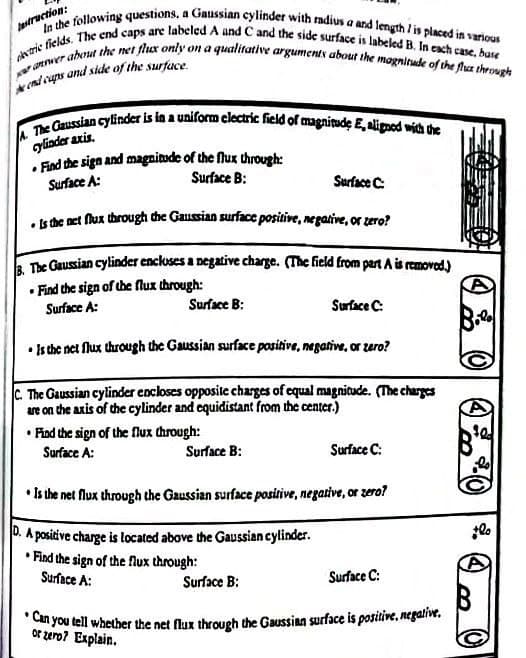aer about the net fluex only on a qualitative arguments about the magnitade of the fha throw In the The Gaussian cylinder is in a uniform clectric field of magniude E, aligned with the • Find the sign and magnitode of the flux through: rie fields. The end caps are labeled A and C and the sidc surface is labeled B. In each case, base dius a and length 1l is placed in various glinder axis. Suface R.
aer about the net fluex only on a qualitative arguments about the magnitade of the fha throw In the The Gaussian cylinder is in a uniform clectric field of magniude E, aligned with the • Find the sign and magnitode of the flux through: rie fields. The end caps are labeled A and C and the sidc surface is labeled B. In each case, base dius a and length 1l is placed in various glinder axis. Suface R.
Chapter6: Gauss's Law
Section: Chapter Questions
Problem 61P: An uncharged spherical conductor S of radius R has two spherical cavities A and B of radii a and b,...
Related questions
Question

Transcribed Image Text:Jastruction:
• Can you tell whether the net flux through the Gaussian surface is positive, negalive.
A The Caussian cylinder is in a uniform electric field of magnitude E, alignod wich the
ar anwer abaut the net flux only on a qualitative arguments about the mognitude of the flux through
avtric fields. The end caps are labeled A and C and the side surface is labeled B. In each case, base
In the following questions, a Gaussian cylinder with radius a and length lis placed in various
end cups and side of the surface
glinder axis,
• Find the sign and magnitude of the flux through:
Surface A:
Surface B:
Surface C:
akthe net fux through the Gaussian surface positive, negative, or zero?
| The Gaussian cylinder enckoses a negative charge. (The field from part A is removod)
• Find the sign of the flux through:
Surface A:
Surface B:
Surface C:
• Is the net flux through the Gaussian surface positive, negative, or zero?
C. The Gaussian cylinder encloses opposite charges of equal magnitude. (The charges
ure on the axis of the cylinder and cquidistant from the center.)
• Find the sign of the flux through:
Surface A:
Surface B:
Surface C:
* Is the net flux through the Gaussian surface positive, negative, or zero?
D. A posicive charge is located above the Gaussian cylinder.
• Find the sign of the flux through:
Surface A:
Surface B:
Surface C:
or zero? Explain.
Expert Solution
This question has been solved!
Explore an expertly crafted, step-by-step solution for a thorough understanding of key concepts.
Step by step
Solved in 7 steps

Knowledge Booster
Learn more about
Need a deep-dive on the concept behind this application? Look no further. Learn more about this topic, physics and related others by exploring similar questions and additional content below.Recommended textbooks for you


Principles of Physics: A Calculus-Based Text
Physics
ISBN:
9781133104261
Author:
Raymond A. Serway, John W. Jewett
Publisher:
Cengage Learning


Principles of Physics: A Calculus-Based Text
Physics
ISBN:
9781133104261
Author:
Raymond A. Serway, John W. Jewett
Publisher:
Cengage Learning